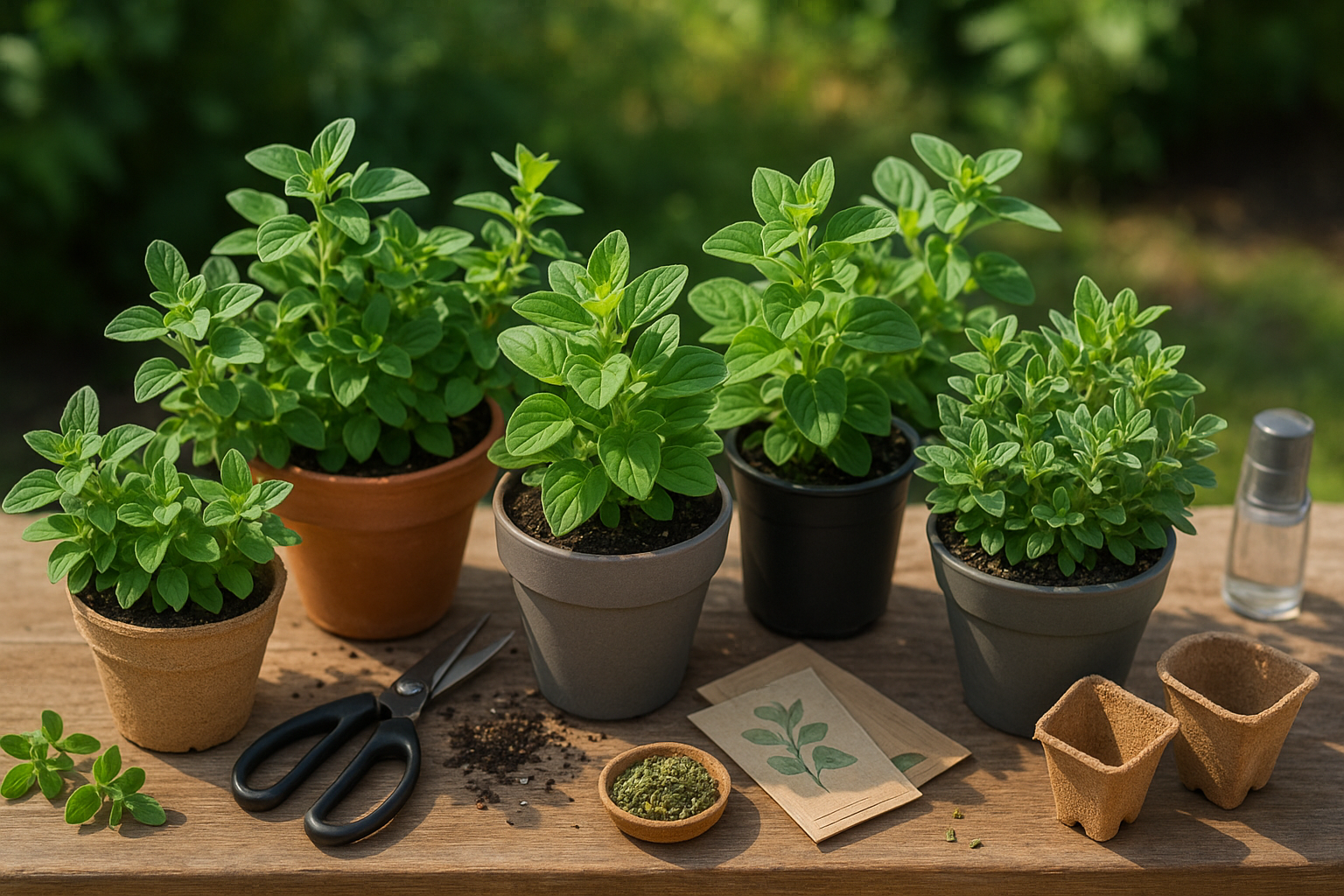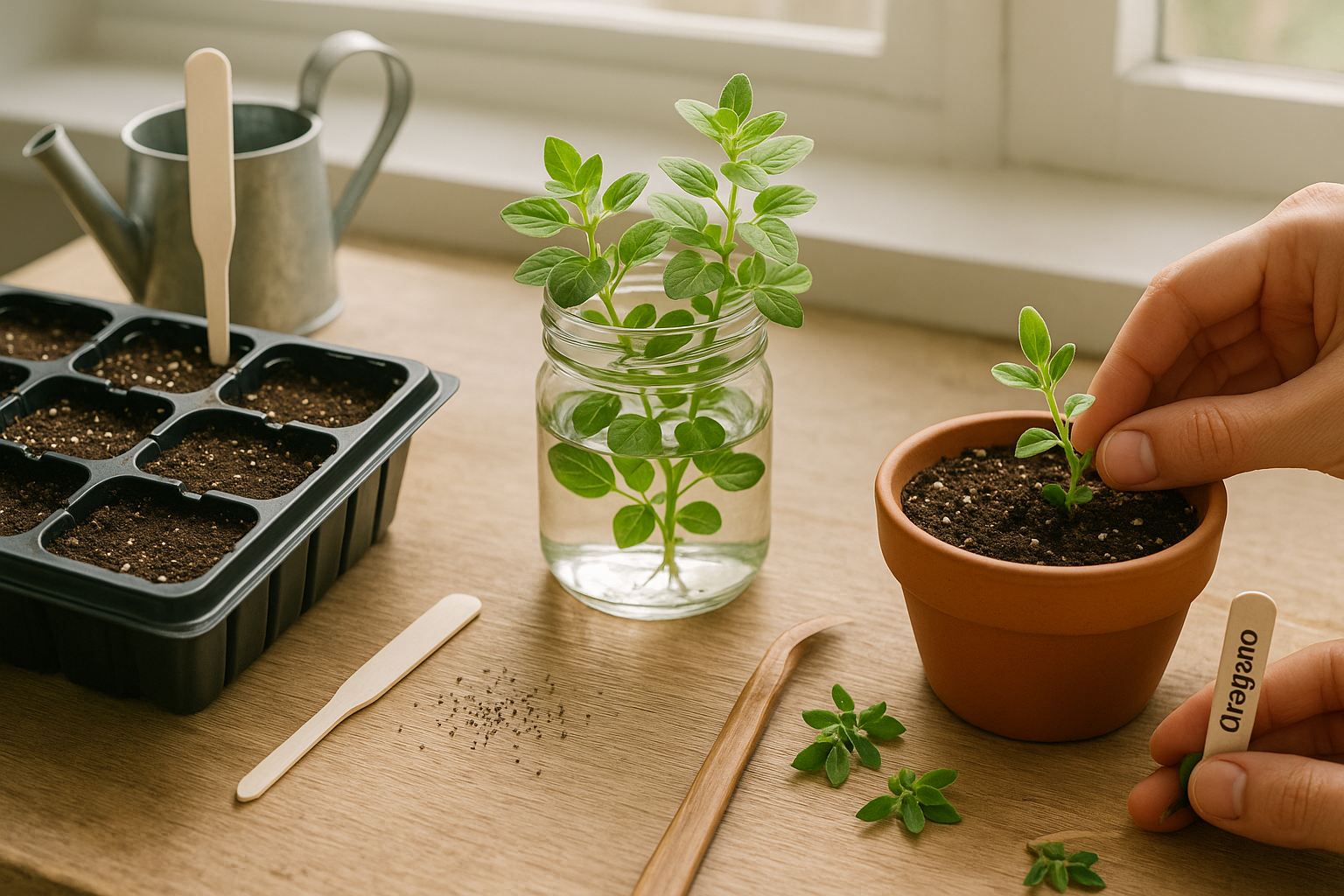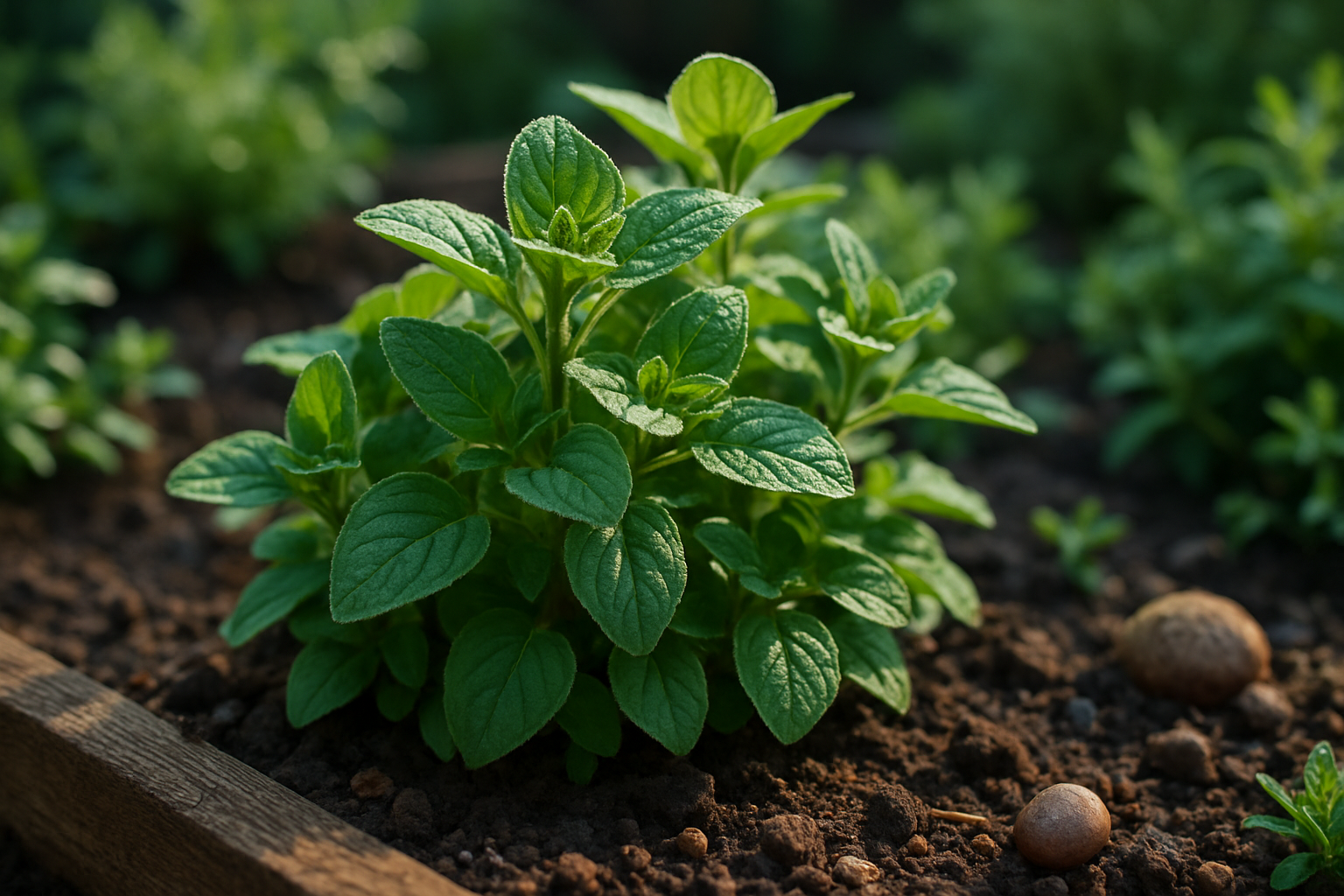Why Grow Oregano?

Oregano is much more than just a pizza topping—this fragrant herb is a staple in kitchens worldwide, prized for its bold flavor and impressive health benefits. With its peppery, slightly minty taste, oregano elevates countless dishes, from Mediterranean salads to hearty pasta sauces.
Beyond its culinary appeal, oregano boasts medicinal properties; it’s packed with antioxidants and has been traditionally used to support immune health, soothe coughs, and aid digestion.
What makes oregano especially attractive to gardeners is how easy it is to grow, whether you’re a complete novice or a green-thumbed pro. As a perennial herb, oregano returns year after year, steadily filling your garden or windowsill pot with lush green leaves.
It thrives with minimal care, tolerating both hot, dry summers and cooler weather, making it nearly foolproof for beginners. Experienced gardeners love that oregano naturally repels many common pests, reducing the need for chemical treatments, and it’s relatively disease-resistant. In fact, its resilience means it often outcompetes weeds and can thrive even in poor, rocky soils.
For busy folks or those looking to create a low-maintenance herb garden, oregano is a perfect choice. Just plant it in well-draining soil, give it some sunlight, and watch it flourish. Sprinkle fresh leaves onto homemade pizzas, brew them in herbal teas, or dry them for use throughout the year—the possibilities and rewards of growing oregano are truly endless.
Choosing the Best Oregano Varieties
When it comes to growing oregano, picking the right variety can make all the difference in flavor and garden success. Greek oregano (Origanum vulgare subsp. hirtum) is a favorite among home cooks, prized for its bold, spicy flavor that holds up well in Mediterranean dishes, sauces, and pizzas.
Italian oregano is actually a hybrid between oregano and marjoram, offering a slightly sweeter, milder taste that works beautifully in pasta sauces and salads. Syrian oregano, sometimes called za’atar, has a complex, citrusy profile popular in Middle Eastern cuisine and spice blends.
For outdoor garden beds, Greek oregano is hardy and high-yielding—perfect for full sun and well-drained soil, thriving even in less-than-ideal conditions. If you’re short on space or want fresh oregano within arm’s reach, Italian oregano adapts well to containers. Choose a pot at least 10 inches wide with good drainage, and place it in a sunny spot.
When buying seeds or seedlings, source from reputable nurseries or online retailers to ensure you’re getting the true variety—look for Latin names on labels for accuracy. Healthy seedlings should have vibrant green leaves without yellowing or spots, and stems should be sturdy rather than leggy or floppy. Avoid plants with signs of pests or mildew.
If you’re starting from seed, opt for organic seeds whenever possible and sow them indoors a few weeks before your last frost date to give your plants a head start. With a little research and attention to plant health, you’ll find it easy to select a flavorful oregano variety that fits your kitchen needs and gardening space.
When and Where to Plant Oregano Outdoors
Planting oregano at the right time sets the stage for a thriving, flavorful herb garden. In most regions, the best time to plant oregano outdoors is after the last spring frost has passed—usually late April to mid-May, depending on your local climate. If you’re in a warmer area with mild winters, you can plant even earlier, but always watch for cold snaps that can stunt tender seedlings.
Oregano loves sunlight, so choose a spot that gets at least six to eight hours of direct sun each day. The more light it gets, the richer the flavor of the leaves. Look for well-drained soil because oregano dislikes soggy roots. If your soil tends to hold moisture, adding some sand or planting on a slight mound can help.
When choosing between garden beds and containers, consider your space and gardening style:
- Garden beds: These allow oregano to spread and produce abundant harvests—perfect if you use a lot of fresh herbs. Keep in mind, oregano can be invasive, so be ready to trim it back or use edging to keep it contained.
- Containers: Growing oregano in containers gives you better control. You can move the plants to the sunniest spots or bring them indoors to overwinter. However, container-grown oregano may dry out faster and will need more frequent watering.
For urban gardeners or anyone with limited space, a sunny pot on a balcony or windowsill can be just as productive as a sprawling garden bed. Whichever option you choose, plant your oregano where you can easily snip fresh sprigs whenever you want a burst of Mediterranean flavor in your kitchen.
How to Plant and Propagate Oregano

Planting oregano at home is simple and rewarding, whether you start from seeds, cuttings, or transplants.
To grow from seeds, fill small pots or seed trays with a well-draining seed-starting mix. Sprinkle the seeds lightly on the surface since oregano seeds need light to germinate, so cover them very thinly or not at all. Mist the soil to keep it moist but not soggy, and place the trays in a warm spot with indirect sunlight—germination usually takes 7-14 days.
For cuttings, snip four-inch stems from a mature oregano plant, strip the bottom leaves, and set the stems in a jar of water or directly into moist potting mix until roots form within two weeks.
Transplants from a garden center are the easiest: simply dig a hole the same depth as the root ball, set the plant in, and firm the soil.
Growing Conditions
Oregano thrives in light, well-drained soil with a pH between 6.0 and 8.0. If planting outside, space plants 12 to 18 inches apart so they don’t crowd. In containers, use a pot at least 6 inches deep with drainage holes. For container growing, choose a loamy mix with added sand or perlite to boost drainage.
Watering and Care
Water young plants sparingly—let the top inch of soil dry between waterings, as oregano hates soggy feet. During early growth, watch for leggy stems (not enough light), yellowing leaves (too much water), or mildew (overcrowding and poor airflow). Solve these issues by providing six hours of sunlight daily, watering less frequently, and thinning seedlings if needed.
Following these tips can help you enjoy healthy, aromatic oregano ready for culinary use just weeks after planting.
Oregano Care
Oregano thrives when its basic care needs are met, and getting your watering routine right is essential for healthy growth. Water oregano when the top inch of soil feels dry to the touch—usually once or twice a week in warm weather and less frequently in cooler months.
Overwatering is a common issue. Watch for yellowing leaves, wilting, or soft stems—these signal soggy roots. On the other hand, underwatered oregano may develop crispy, brown-edged leaves that quickly droop. To avoid both extremes, always let the soil dry out a bit between waterings and use well-draining pots or garden beds.
When it comes to feeding, oregano isn’t a heavy feeder and benefits most from a light touch. Apply a balanced, all-purpose organic fertilizer like compost or diluted fish emulsion every four to six weeks during the growing season. Avoid over-fertilizing, as this can dilute the flavor of the leaves.
For ongoing maintenance, regular pruning keeps oregano bushy and productive. Snip back stems just above a set of leaves every few weeks, especially before flowering, to encourage new growth. Don’t discard the trimmings—they’re perfect for your kitchen!
Finally, oregano is thankfully resilient, but stay vigilant for common pests like aphids or spider mites. Blast them off with a gentle spray of water or use neem oil if needed. Preventative care is your best defense:
- Ensure adequate air circulation
- Avoid overhead watering to reduce fungal risk
- Remove any unhealthy or diseased leaves promptly
With these simple care strategies, your oregano plant will reward you with lush harvests all season long.
Harvesting and Using Fresh Oregano
To get the most robust flavor from your oregano plants, timing your harvest is key—wait until just before the plant blooms, usually in late spring or early summer, when the essential oils are most concentrated. Harvest in the morning after the dew has dried but before the sun gets too hot, as this helps preserve the leaves’ vibrant oils.
Use clean, sharp scissors or garden shears to snip stems, leaving at least two-thirds of the plant so it continues growing. If you plan to use oregano fresh, rinse the cuttings gently under cool water, pat them dry, and strip the leaves from the stems.
Fresh oregano adds a fragrant, zesty kick to countless dishes. You can:
- Sprinkle the chopped leaves over pizzas
- Toss them into pasta sauces
- Mix into salad dressings for a burst of herbal flavor
For a quick herbal remedy, steep a few fresh oregano sprigs in hot water for a soothing tea that’s said to help with sore throats and digestive complaints. You can also muddle oregano leaves with a bit of honey and lemon for a simple homemade cough syrup.
In everyday cooking, fresh oregano is a star in Mediterranean recipes, blending well with tomato, garlic, and olive oil. It’s a go-to herb for marinades, roasted vegetables, or grilled meats. Try combining it with other fresh herbs like basil and parsley for a lively gremolata to top seafood or chicken—turning backyard-harvested oregano into kitchen magic.
Drying, Storing, and Overwintering Oregano
Drying and storing oregano is an easy way to preserve its bold flavor for year-round use. After harvesting, rinse the stems and gently pat them dry. For air-drying, bundle 5–10 stems with twine and hang them upside down in a warm, dark, well-ventilated spot—kitchens or pantries work great. Check them after a week; the leaves are ready when they crumble easily.
If you want quicker results, spread the leaves on a baking sheet and place them in an oven at the lowest setting for a couple of hours, or use a food dehydrator. Once dried, strip the leaves from the stems and store them in airtight glass jars away from light and heat to maximize flavor. Avoid plastic bags, as they can let in moisture and dull the taste.
Overwintering Oregano
Oregano thrives as a hardy perennial in zones 5 and up, but cold climates require extra care. Outdoors, mulch the base with 2–4 inches of straw or leaf mold before the first frost to insulate the roots. In especially harsh winters, consider potting a small plant and overwintering it indoors near a sunny window—oregano loves at least 6 hours of light, so supplement with a grow light if natural sunlight is scarce.
Common Questions
- How long does dried oregano last? Properly stored, it retains its best flavor for about 6 months, though it remains safe to use longer.
- Can you revive oregano after winter? Yes! Prune back dead stems in spring, and new growth will sprout from the base.
For a longer-lived plant, avoid harvesting more than one-third of the growth at once, and divide mature plants every 3–4 years to invigorate their roots. With a little care, you can enjoy homegrown oregano season after season.
